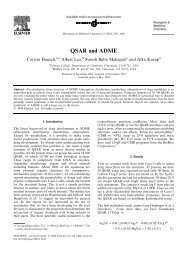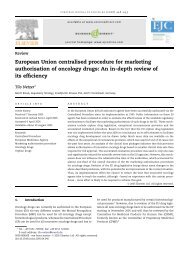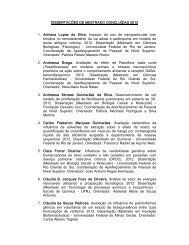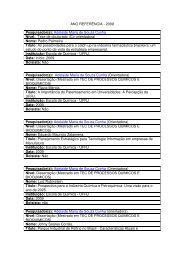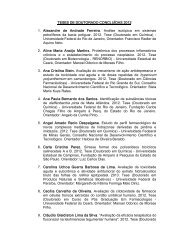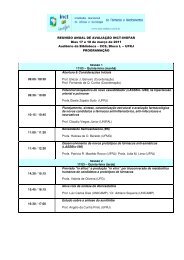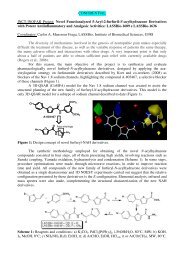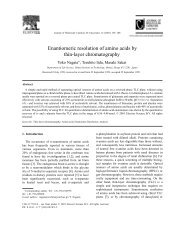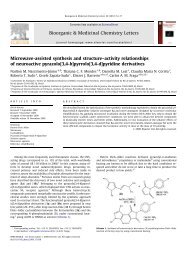View - ResearchGate
View - ResearchGate
View - ResearchGate
- No tags were found...
You also want an ePaper? Increase the reach of your titles
YUMPU automatically turns print PDFs into web optimized ePapers that Google loves.
Perspective Journal of Medicinal Chemistry, 2004, Vol. 47, No. 18 4347amples of microbial preparation of mammalian drugmetabolites are given in recent reviews. 67,68 Examplesinclude pravastatin, an HMG-CoA reductase inhibitorthat is a 6R-hydroxylated derivative of compactin (mevastatin)produced by biotransformation using Streptomycescarbophilus. In fact, this microbial biotransformationprocess is used to manufacture pravastatinrather than a chemical synthesis. 69 Cunninghamellaelegans was reported by Zhang and co-workers toproduce eight metabolites, including the two majormammalian metabolites (11-hydroxy and N-demethylated),after incubation with the tricyclic antidepressantamitryptyline. 70 Several of these metabolites are knownto have pharmacological activities.In Vivo MethodsMetabolites can be generated in vivo following compoundadministration to preclinical animals or human.In vivo samples such as plasma, 35,37 urine, 69 and bile 33can be used to obtain metabolites. Metabolites can alsobe obtained from drug-metabolizing organs such as liverobtained from animals pretreated with the desiredcompound.In vivo methods of generating active metabolite canbe especially useful when active metabolites are formedextrahepatically because extrahepatic systems are notas widely used as hepatic systems for in vitro generationof metabolites.Recent Advances in the StructuralCharacterization of MetabolitesUntil recently, the majority of the effort to identifymetabolites and assign exact structures was undertakenin the late stage of the drug development process. Theidentification process involved, in most cases, a lengthyand labor-intensive isolation of metabolites and the useof radiolabeled compounds. Fortunately, these processeshave now been obviated or greatly reduced in scalebecause of the recent advances in high-pressure liquidchromatography-mass spectrometry (LC/MS), highpressureliquid chromatography-mass spectrometry/mass spectrometry (LC/MS/MS), and liquid chromatography-nuclearmagnetic resonance spectroscopy (LC/NMR). Below, we will briefly discuss the recent advancesin the LC/MS or LC/MS/MS and LC/NMR technologieswith respect to metabolite structure identification.LC/MS or LC/MS/MSBy coupling liquid chromatography with mass spectrometry(LC/MS or LC/MS/MS), it is now possible toquantify and determine on-line the identity of drugs andmetabolites of diverse structures in different biologicalsystems with unprecedented speed, sensitivity, andspecificity. 71-76 LC/MS, particularly in combination withatmospheric pressure ionization (electrospray ionization(ESI) and atmospheric pressure chemical ionization(APCI)) techniques, can now be used to analyze polar,nonvolatile, and thermally labile drugs and metabolites.77-79 Less polar molecules can be analyzed with therecently introduced atmospheric pressure photoionizationtechnique. 79 Advances in computer software technologyhave also greatly facilitated LC/MS data acquisitionand interpretation. 80,81 LC/MS is a robust techniqueand is amenable to automation. 82 The ability to analyzesamples from different sources and chemotypes on-linewith such great speed and sensitivity using LC/MS hasindeed revolutionized the drug discovery and developmentprocess.For detection and structural elucidation of metabolites,various tandem mass spectrometric (MS/MS)experimental techniques such as product ion, precursor(parent) ion, and neutral-loss scans are used. 73-76,79,82-84The major types of instruments used for tandem massspectrometric studies are triple quadrupole, ion trap,time-of-flight mass spectrometers, and to a lesser extentmagnetic sector and Fourier transform ion cyclotronresonance (FTICR) mass spectrometers. The recentlyintroduced coupled mass spectrometers, such as quadrupole-time-of-flight(Q-TOF) 85 and quadrupole-linearion trap 86,87 mass spectrometers, are also becomingpopular.Multiple-stage mass spectrometric (MS/MS n , n > 2)experiments can be performed by both ion trap andFTICR mass spectrometers. Ion traps are more widelyused for structural identification of metabolites. 73,88,89Ion trap mass spectrometers are highly sensitive, andstructural information can be obtained with low quantities(picogram) of metabolite. 90For exact mass determination, high-resolution massspectrometers such as double-focusing magnetic sectoror FT-ICR have traditionally been used. The recentlycoupled highly sensitive quadrupole time-of-flight massspectrometers (Q-TOF) in combination with electrosprayionization can also be used for high-resolution measurements.85,91 With Q-TOF, a mass accuracy of greater than5 parts per million can be achieved and the elementalcomposition of metabolites can be determined. Quiterecently, a triple quadrupole mass spectrometer basedmethod demonstrated the capability to provide enhancedresolution and accurate mass measurements. 84Exact mass measurement capability in combinationwith neutral loss and precursor ion scan modes by triplequadrupole mass spectrometers can greatly enhance theidentification of metabolites.As described above, significant advances in massspectrometric technology in terms of ionization techniques,mass analyzer capability, and data reductionhave greatly facilitated the identification of metabolites.These, along with significant advances in liquid chromatographytechnologies, have made LC/MS the methodof choice for initial identification of metabolites incomplex biological matrices. 36,72LC/NMRNuclear magnetic resonance (NMR) is the premieranalytical method for the determination or confirmationof molecular structures. NMR can unambiguously solveregiochemistry questions that are frequently encounteredin metabolite structure characterization throughthe use of the appropriate repertoire of 1D and 2D homoandheteronuclear experiments. 92,93The past 15 years has seen multiple advances in NMRhardware and software that has broadened the applicationof NMR to drug discovery and development. 94 Theadvances that have the largest impact include increasesin sensitivity and solvent suppression pulse schemes.The gain in sensitivity can be directly attributed toadvances in probe design. For example, the amount of



